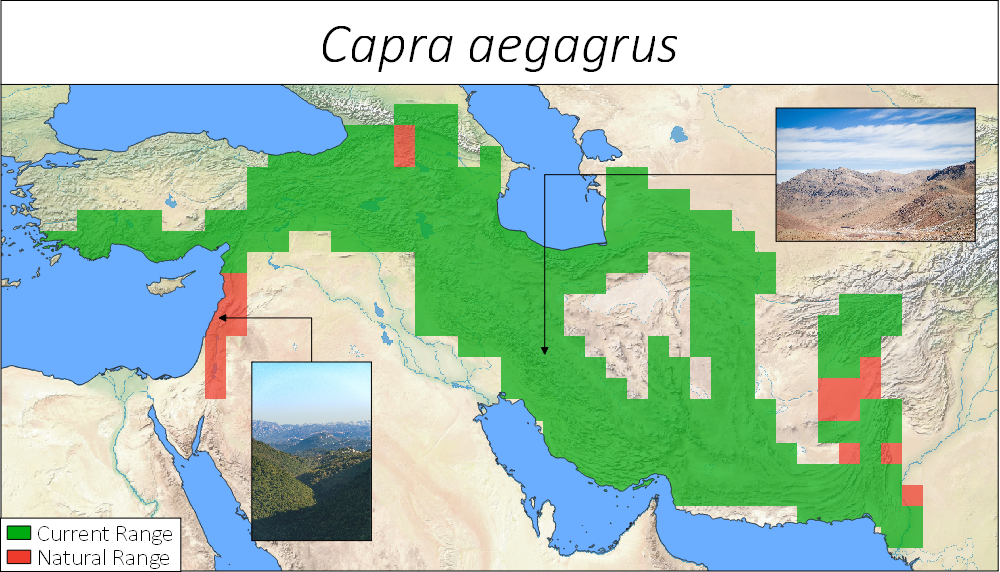The Wild Goat (Caprus aegagrus)
Figure 1. The Bezoar ibex, Caprus aegagrus aegagrus, a sub-species of the Wild Goat.
Terms of use: This image is licensed under a Creative Commons Attribution-ShareAlike 4.0 International. It is attributed to Alexander Malkhasyan. The image is unedited and the original can be found here
Taxonomy
The Wild Goat, Caprus aegagrus, is a medium-sized caprine, native to the mountains of southerly Eurasia and ancestral to the domestic goat (4). It is subdivided into four subspecies (1): The Bezoar ibex (C. a. aegagrus), Sindh ibex (C. a. blithy), the Chiltan ibex (C. a. chialtanensis) and, controversially, the Cretan goat or ibex (C. a. cretica), which is generally considered a feral domestic (5). As noted, all domestic goats are descended from C. aegagrus, more specifically the Bezoar ibex (4). This seemingly occurred in two separate events: First on the Central Iranian Plateau, and latter in Eastern Anatolia. It is to the latter domestication event that modern domestic goats owe the vast majority of their ancestry (4).
Distribution
The Wild Goat has a broad distribution, following mountain-lines from the Aegean in the west, through Anatolia and the Caucasus, over the Zagros and even into southern Pakistan (3). Once, its distribution was even larger, stretching into the Levant, with historical records from Jordan, Lebanon and Syria. Fossil remains show that it even reached into Israel in the early Holocene (3). Further south, it was replaced by the Nubian ibex (Capra nubiana) (6), an animal whose range overlapped with the Wild Goat throughout the southern Levant.
The occurrence of Wild Goats in Europe is long and contested. The aforementioned Cretan goat, known locally as the Kri-kri, was previously considered an endemic sub-species. Now, however, it has been shown by genetics to be descended from feral domestics (5). Bezoar ibexes have historically occurred through the mountains of Greece and southern Bulgaria, even into the 20th century, yet are unknown from the fossil record (2). It would appear, then, that the Straits of the Bosporus were the natural edge of their distribution, and that more westerly occurrences are all results of human introductions, either of wild animals or domesticated lineages.
The distribution of Capra aegagrus, with the current range in green and the estimated natural range in red. Data was obtained from Phylacine (2). Samples of habitat within the range are also included.
Morphology and ecology
The Wild Goat is a medium-sized caprine, whose exact shape and size varies from sub-species to sub-species. The body length of the Bezoar ibex is between 120-160 cm, with a height at the withers of 70-100 cm. Their legs are relatively short, but with long, saber-shaped horns, curving backwards. This trait is dimorphic, and the females have only short hornlets. Colour is uniform between the sexes, changing with the seasons. In summer, their coats are reddish, in the winter, a greyish brown (1). As with many species of goats, both sexes have black beards, slightly longer in the males.
Generally alpine animals, they inhabit rocky crags and montane forests (3). Not generally migratory, wild goats nevertheless seek differing pastures depending on the seasons, avoiding southern slopes in summertime. The exacts of their habitat vary, but they show a strong preference for high and inaccesible terrain, with males seeking the most elevated outside of rutting season (3). Their diet consists of grasses, herbaceous plants and shrubs, varying seasonally and geographically. As with many caprines, Wild Goats have decent arboreal abilities, and are capable of scaling small trees in search of food (3).
This latter fact is doubtless relevant for more than feeding, as Wild Goats are prey to several species. Wolves (Canis lupus), bears (Ursus arctos), lynx (Lynx lynx) and even golden eagles (Aquila chrysaetos) have all been recorded hunting goats, particularly juveniles (3). None are substantial predators, however, due perhaps in large part to the former three’s lacking predilection for alpine habitats. Far more significant are leopards (Panthera pardus) and cheetahs (Acinonyx jubatus) (3). Both are major predators of Wild Goats in the regions where they still co-exist, that being Iran for Cheetahs as well as the southern Caucasus and Pakistan for leopards. Evidently, these species, alongside possible lions (Panthera leo) and scimitar cats (Homotherium latidens) would have been the Wild Goat’s primary predators in prehistoric times.
Citations
Ahmed, A., Vlasseva, A., Kitanova, S., Genov, P. V. (2015). BEZOAR WILD GOAT (CAPRA AEGAGRUS ERXLEBEN, 1777) – HISTORY AND OPPORTUNITIES FOR DEVELOPMENT OF THE SPECIES IN BULGARIA. Institute of Biodiversity and Ecosystem Research. 171-175.
Faurby, S., Pedersen, R. Ø., Davis, M., Schowanek, S. D., Jarvie, S., Antonelli, A., & Svenning, J.C. (2020). PHYLACINE 1.2.1: An update to the Phylogenetic Atlas of Mammal Macroecology. doi:10.5281/zenodo.3690867
Weinberg, P. & Ambarli, H. (2020). Capra aegagrus. The IUCN Red List of Threatened Species 2020: e.T3786A22145942. DOI: https://dx.doi.org/10.2305/IUCN.UK.2020-2.RLTS.T3786A22145942.en.
Naderi, S., Rezaei, H., Pompanon, F., Blum, M., Negrini, R., Naghash, H., Balkız, Ö., Mashkour, M., Gaggiotti, O., Ajmone-Marsan, P., Kence, A., Vigne, J. and Taberlet, P., (2008). The goat domestication process inferred from large-scale mitochondrial DNA analysis of wild and domestic individuals. Proceedings of the National Academy of Sciences. 105. 46. 17659-17664. DOI: https://doi.org/10.1073/pnas.0804782105
Bar-Gal, G., Smith, P., Tchernov, E., Greenblatt, C., Ducos, P., Gardeisen, A. and Horwitz, L., (2002). Genetic evidence for the origin of the agrimi goat (Capra aegagrus cretica). Journal of Zoology. 256. 3. 369-377. DOI: 10.1017/s0952836902000407
Yom-tov, Y., Bar-Yosef, O., Tchernov, E. Dayan, T. (1986). Animal Exploitation in Ujrat El-Mehed, a Neolithic Site in Southern Sinai. Paléorient. 12. 2. DOI: 10.3406/paleo.1986.4413


